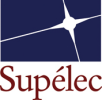Designing III-V multijunction solar cells on silicon
Résumé
Single junction Si solar cells dominate photovoltaics but are close to their efficiency limits. This paper presents ideal limiting efficiencies for tandem and triple junction multijunction solar cells subject only to the constraint of the Si bandgap and therefore recommending optimum cell structures departing from the single junction ideal. The use of III-V materials is considered, using a novel growth method capable of yielding low defect density III-V layers on Si. In order to evaluate the real potential of these proposed multijunction designs, a quantitative model is presented, the strength of which is the joint modelling of external quantum efficiency and current-voltage characteristics using the same parameters. The method yields a single parameter fit in terms of the Shockley-Read-Hall lifetime. This model is validated by fitting experimental data of external quantum efficiency, dark current, and conversion efficiency of world record tandem and triple junction cells under terrestrial solar spectra without concentration. We apply this quantitative model to the design of tandem and triple junction solar cells, yielding cell designs capable of reaching efficiencies without concentration of 32% for the best tandem cell and 36% for the best triple junction cell. This demonstrates that efficiencies within a few percent of world records are realistically achievable without the use of concentrating optics, with growth methods being developed for multijunction cells combining III-V and Si materials.
Domaines
Physique [physics]| Origine | Fichiers produits par l'(les) auteur(s) |
|---|
Loading...

